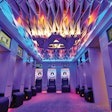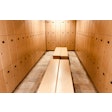![University of Michigan [Photo courtesy of RDG Planning & Design]](https://img.athleticbusiness.com/files/base/abmedia/all/image/2020/08/ab.spotlight720_feat.png?auto=format%2Ccompress&q=70&w=400)
Locker room design has changed over the years to reflect the evolving preferences of end users. What impact, if any, will unprecedented public awareness of infectious disease precipitated by a pandemic have on future design? Athletic Business asked architects to weigh in on how spaces already dedicated to personal hygiene might change in the future to further promote patron health. Here are several ideas.
Increased privacy, cleanliness
Recent trends toward individual privacy and gender neutrality have already moved locker rooms toward enhanced social distancing.
Private changing rooms and individual shower areas are already popular in the United States. Public zones that pair lockers with sinks independent of the traditional locker room have caught on elsewhere. "This is already becoming the norm in Canada and most of Europe," says Chris Kastelic, a principal at Perkins and Will. "It does have some impact on space and plumbing cost, and isn't really something that can easily be retrofitted to an existing facility, but there are several benefits. Everyone has a private room and better privacy for all, and it removes any gender stigmas, but rooms can also be cleaned continuously throughout the day rather than waiting until after hours, and there are fewer opportunities to come in contact with others. Close contact in locker rooms wasn't ideal even before COVID-19."
"The feedback we have gotten regarding some of the newest installations is that users keep single-user spaces much cleaner than traditional locker rooms, and that staff find them much easier to maintain since they can be cleaned when not in use rather than having to wait until after hours to clean," Hastings+Chivetta principal Erik Kocher says. "Imagine shutting your traditional locker rooms down, say, four times a day for deep cleaning instead of cleaning the single units when unoccupied."
Moreover, the single-occupancy showering trend has transcended the recreation center realm. Says HOK's Emily Ostertag, "Even with professional and collegiate athletics, where ganged showers were always standard, we have seen more interest in private showers plus changing areas pre-COVID, and I suspect that request will only increase post-COVID."
![University of Portland Beauchamp Recreation & Wellness Center [Photo by Christy Radecic]](https://img.athleticbusiness.com/files/base/abmedia/all/image/2020/08/ab.spotlight720a.png?auto=format%2Ccompress&fit=max&q=70&w=400) University of Portland Beauchamp Recreation & Wellness Center [Photo by Christy Radecic]
University of Portland Beauchamp Recreation & Wellness Center [Photo by Christy Radecic]
Patron circulation
During those moments when locker room users are not separated by their own private walls, social distancing can be tricky.
"Like no time in our past, we've been working with clients to find out how many persons can fit into various areas of their buildings," says Jack Patton, a principal at RDG Planning & Design. "We've drawn many 6-foot-diameter circles these past few months to help answer this question. The simple math is that floor area divided by 40 equals the approximate number of patrons with a 6-foot social distance, accounting for 10 percent of the space for open circulation, exit and entry."
"I anticipate owners and designers to pay even more attention to the circulation paths within the locker room to maintain a 6-foot separation as best as possible," adds CannonDesign principal Colleen McKenna. "For example, consider a one-way enter and exit scenario into the shower or toilet areas. Same goes throughout the overall locker room's actual lockers or grooming areas. Both scenarios will reduce crisscross circulation patterns among patrons."
"Measured diagrams, floor markings, posted signs, and elimination of some furniture and equipment are all necessary in the end," Patton says.
Loitering in locker rooms could be discouraged. In particular, the high-end locker room lounge area, complete with furniture groupings, will likely require a rethink, according to Ostertag. "The lounge/waiting areas outside and inside of recreation lockers will be less desirable moving forward," she predicts. "It will be interesting to see how this affects professional and collegiate athletic locker rooms and lounges."
RELATED: PRODUCT SPOTLIGHT: Locker Room and Laundry Components
Hands-free fixtures
Regardless of the actual amount of time individual patrons spend in locker rooms, these have traditionally been high-touch areas — but they don't have to be.
"I believe we will see all fixtures become hands-free," Kocher says. "While many locker rooms are designed this way now, entry doors, flush valves, faucets, paper towel dispensers, lights, and hand and hair dryers will now all be hands-free. Locker doors will open, close and lock on a voice command: 'Locker 145 open-authorization Erik Kocher.' It sounds a little like Star Trek Enterprise's self-destruction sequence, but it will eliminate the need to touch the locker. In locker rooms that have proper privacy sight lines, entry doors will be eliminated."
"There are many ways to avoid even having a door into a locker room as long as sightlines are mitigated from any public viewing. If a door is required, consider pushing the door out as you exit a restroom to avoid touching the door handle after you have washed your hands," McKenna says, adding, "Hand dryers are common practice from an environmental perspective, but they are currently under review in terms of the air blowing and possibly spreading germs."
Other locker room fixtures may experience alterations. Ostertag sees greater spacing between individual lockers and vanities, and Patton predicts partitions will be about more than mere modesty. "We forecast a more private toileting experience," he says, "with full-height sidewalls between water closets and more full-panel screens between urinals."
McKenna agrees. "Toilet stalls are notoriously tight and therefore may become wider, along with full-length partitions down to the floor and up to the ceiling," she says. "Deeper partitions will be required in between urinals."
What about now?Short of renovation or new construction, what can facility operators do today to mitigate transmission risk as they reopen their locker room spaces? "Lockers may be temporarily blocked off and spread out to maximize social distancing," says Colleen McKenna, a principal at CannonDesign. "I would not be surprised if many locker rooms are closed temporarily for safety reasons, even as facilities begin to open up. Sauna and steam rooms will remain closed. Lounge areas are likely to be blocked off to discourage socializing in a confined space." Cordoning off certain spaces may have its drawbacks, too, McKenna adds. "While blocking off every other toilet or sink may seem like a good idea at first, by default it increases the number of uses per stall. It goes without saying that cleaning protocols will be changed forever to prevent and reduce the transmission of germs." |
Advanced sanitation
Several design selections are already available to mitigate disease spread, including easily cleaned non-porous surfaces. However, high-tech sanitation strategies may become more commonplace.
"As for design changes in the next five to 10 years, consider a single-user changing space with high-powered UV lights installed in the ceiling, walls and floor for burst cleaning after a user leaves the room," Kocher says. "Surfaces will be designed to self-clean based on the molecular make-up of the product. Wiping down a grooming shelf will no longer be required. Instead, the product will react with any virus on its surface and kill the intruder similar to antimicrobial products used on carpets today. Lockers themselves will emit a UV light burst to sanitize them after each use."
According to Patton, high-intensity UV light is already being used for the nightly sanitation of passenger busses in China and is similar to the UV filtration used in some commercial swimming pools here in the U.S. "This could be a nightly process, or more frequent depending on the number of rooms, light solutions selected, and other operational questions," he says. "Patrons will need to be kept out of the rooms while sanitation occurs, but it's fast, easy and tech-enhanced. Flip on the light and let the virus-killing begin."
RELATED: Find more solutions for your facility in the Buyers Guide
Air handling
Locker rooms can be uncomfortable places from a respiratory perspective, even without pandemic concerns hanging overhead. How the air is handled in these spaces may see significant changes in future designs.
"There are several key strategies to deal with the virus, specifically from an HVAC standpoint," according to Patton, who names these three in particular: eliminate, reduce and dilute. "Eliminate the virus. There are electrostatic and filtration ways to keep it and kill it in the airstream. Reduce the virus. Some less-expensive filtration systems can effectively reduce the overall quantity of airborne virus contaminants. Dilute the virus. While not every building space can be efficiently conditioned with 100 percent outside air, we will see even more spaces conditioned this way going forward. This is the process of pulling some fresh air from outside a building and mixing it with air returned from the building itself. This helps in diluting the density of any airborne virus contaminants. Everyone loves fresh air. We will see much more of this, where practical. An old adage says, 'Dilution is the solution to pollution.' This is sage advice in our current world."
Long-term outlook
Once-in-a-lifetime (fingers crossed) events have a way of altering perceptions. Will the pandemic change the way prospective users view locker rooms in any lasting — if not permanent — way?
"The pandemic has naturally brought about a renewed concern for cleanliness and hygiene to the point that patrons may avoid using locker rooms at all, except for the toilets and sinks," McKenna says. "It took years for locker rooms to earn the attention and care on par with other well-designed spaces in a facility, and now it may be years again before locker rooms can return to their pre-pandemic stature."
Ostertag likewise sees potential for locker room use becoming more limited. "I think the general interest and desire for a rented locker will decrease after COVID," she says. "In return, this will decrease the number of rentable lockers needed and overall locker sale revenue. The challenge moving forward will be how to appropriately space lockers but not waste valuable square footage.
"I also believe clients and users will request lock types that don't require contact, such as RFID carded locks similar to hotel doors."
Kocher, meanwhile, allows himself to look beyond the immediate challenges presented by the novel coronavirus pandemic to a locker room almost unrecognizable by today's standards. "Imagining locker room innovation way into the future, I can think only of the original James Bond movie reimagined in the Austin Powers series when Austin rides across the moving shower device," he says. "Or perhaps, even further ahead, we will no longer need locker rooms because we will be using clothing that self-cleans as we wear it. After working out, you will activate via voice command a self-cleaning sequence that will clean and dry both you and your bodysuit so you will be immediately ready to head back to work. No changing or showering required!"
This article originally appeared in the July | August 2020 issue of Athletic Business with the title "Designing locker rooms for the post-pandemic world." Athletic Business is a free magazine for professionals in the athletic, fitness and recreation industry. Click here to subscribe.





































